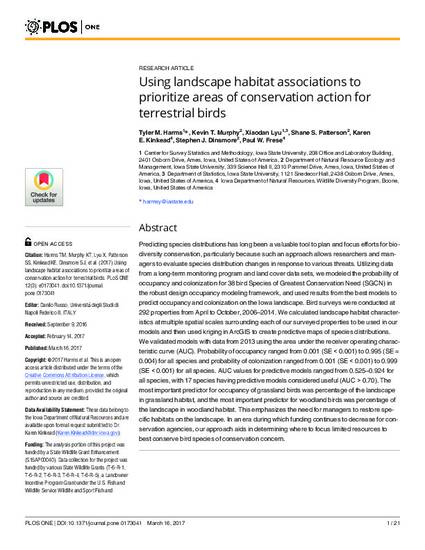
Predicting species distributions has long been a valuable tool to plan and focus efforts for biodiversity conservation, particularly because such an approach allows researchers and managers to evaluate species distribution changes in response to various threats. Utilizing data from a long-term monitoring program and land cover data sets, we modeled the probability of occupancy and colonization for 38 bird Species of Greatest Conservation Need (SGCN) in the robust design occupancy modeling framework, and used results from the best models to predict occupancy and colonization on the Iowa landscape. Bird surveys were conducted at 292 properties from April to October, 2006–2014. We calculated landscape habitat characteristics at multiple spatial scales surrounding each of our surveyed properties to be used in our models and then used kriging in ArcGIS to create predictive maps of species distributions. We validated models with data from 2013 using the area under the receiver operating characteristic curve (AUC). Probability of occupancy ranged from 0.001 (SE < 0.001) to 0.995 (SE = 0.004) for all species and probability of colonization ranged from 0.001 (SE < 0.001) to 0.999 (SE < 0.001) for all species. AUC values for predictive models ranged from 0.525–0.924 for all species, with 17 species having predictive models considered useful (AUC > 0.70). The most important predictor for occupancy of grassland birds was percentage of the landscape in grassland habitat, and the most important predictor for woodland birds was percentage of the landscape in woodland habitat. This emphasizes the need for managers to restore specific habitats on the landscape. In an era during which funding continues to decrease for conservation agencies, our approach aids in determining where to focus limited resources to best conserve bird species of conservation concern.
Available at: http://works.bepress.com/stephen_dinsmore/105/

This article is published as Harms TM, Murphy KT, Lyu X, Patterson SS, Kinkead KE, Dinsmore SJ, et al. (2017) Using landscape habitat associations to prioritize areas of conservation action for terrestrial birds. PLoS ONE 12(3): e0173041. Doi: 10.1371/journal.pone.0173041.